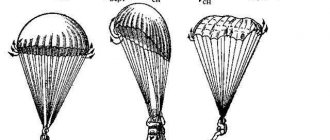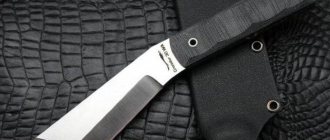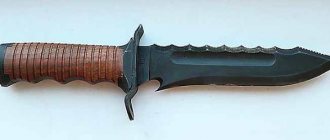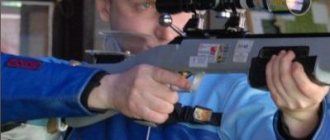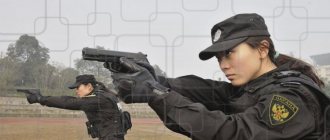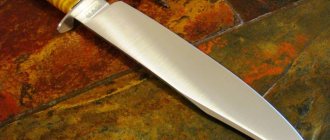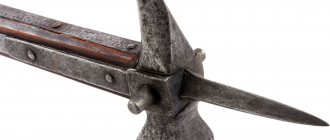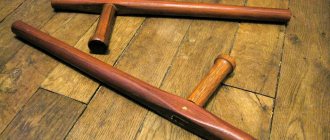Knives have been an indispensable tool in human life for thousands of years. And if earlier they were used solely for the purpose of survival, then in our time they are an important tool that is used in many branches of human activity. So, for various Russian troops, their own specialized weapons are being developed, necessary to perform specific tasks of the unit, and for the Airborne Forces this is a sling knife.
Airborne paratrooper knife.
Features and purpose of the landing sling cutter
A paratrooper's knife, better known as a sling cutter, is a specific tool designed for cutting ropes or slings. The classic model is a diamond-shaped blade and has a serrated sharpening.
This weapon was created in the 30s of the twentieth century, especially for parachutists, so that they could easily free themselves from the parachute or escape in case of failure during landing. Thus, the sling cutter has become an indispensable element of equipment for paratroopers all over the world.
The knife of a paratrooper of the USSR Airborne Forces had a characteristic appearance that could not be confused with anything. The blade had a diamond shape with a rounded end. This model coped well with the assigned tasks and was also an excellent tool for survival.
And although its main purpose was to cut lines, it also coped well with combat missions. The classic model of the USSR had a length of 23 cm, 13 of which were on the handle.
But there were other modifications of the weapon, differing in size and shape.
Terms of use
To open the inertial weapon, you need to release the latch. For this to happen, just turn it down and shake vigorously. Then the blade pops out of the handle.
The paratroopers used the pocket of their paratrooper pants to store weapons. The pocket notch was located above the right knee. An additional cord was additionally connected to the jacket, and the second end of the cord was fixed to the handle. This technique helped to quickly remove the weapon if necessary.
We can say that the only drawback of the knife was the inability to disassemble the body. This applies to versions 1 and 3. In addition, the mouth quickly became clogged with dirt, and the moisture provoked a change in the texture of the wood used to make the handle.
After the moisture evaporated, the blade dried out, but began to jam. It was impossible to get to the housing sinuses without disassembling.
The history of the creation of the paratrooper knife
Since the early 20s of the last century, parachutes have become a mandatory attribute of equipment. This is due to the fact that at that time they were actively creating new models of aircraft that were not reliable enough. Parachutes began to be used for intentional jumps only in the late 30s.
Old Soviet paratrooper knife.
In the 30s of the last century, the first separate branches of parachute troops appeared in the Soviet Union. The first detachment of 12 people originated in Voronezh; a few years later their number increased to 1,800 people.
Demonstration performances were organized periodically; in 1936, Germany was inspired by the idea and considered the possibility of quickly attacking the enemy with the help of paratroopers. Already in the first days of World War II, German troops successfully captured enemy targets.
At that time, they used a rather primitive parachute, which had a number of disadvantages, including:
- the parachute opened with a strong jerk;
- high rate of descent;
- the paratrooper did not have the ability to set the direction and control the descent.
Another design flaw was the impossibility of quickly folding the dome; during gusts of wind, the soldier was dragged, so he needed a reliable knife that would allow him to quickly free himself. Then the command gave the order to create a sling cutter, which has become an integral element of equipment since 1937.
The German paratrooper's knife was created by experienced gunsmiths; it was characterized by its small size and simplicity, so it quickly became popular among soldiers.
German paratrooper knives from World War II
The first models of airborne knives were produced at the height of World War II. They had clips for fixing weapons on clothes, which are successfully used in our time.
M-1937 is the first model of such a weapon; in appearance it resembled an ordinary penknife, but the blade was attached with copper rivets to a wooden handle. To open the sling cutter, no special effort was required; it was enough to press the latch (spring), tilt the tool forward and swing it vigorously.
Stainless steel was used as a raw material, and the knife had the following dimensions:
- blade length 107 mm;
- butt thickness 4 mm;
- The kit included an awl-pile, 93 mm long.
Among the disadvantages of this model it is worth noting:
- frequent breakdowns of the retaining spring;
- the design of the knife could not be disassembled, which made cleaning the weapon difficult in the field.
The second modification, M-1937/II, was produced from 1941 to 1945; it had a number of improvements, in particular, it was collapsible, which made cleaning easier.
Gravity sling cutter M-1937 Third Reich (Paratrooper Knife).
In the models of the second modification, in order to save money, they used not nickel for coating, but a layer of a special oxide substance. Towards the end of World War II, carbon steel was used. This affected the appearance of the weapon; the color was darker.
If we talk about the dimensions, they were the same as in the first modification.
Description of the knife "Sling cutter"
The main difference between the weapon and other knives in this category is the ability to fold the blade inside the body. We can say that the only drawback of the knife was the inability to disassemble the body. This applies to versions 1 and 3. In addition, the mouth quickly became clogged with dirt, and the moisture provoked a change in the texture of the wood used to make the handle.
After the moisture evaporated, the blade dried out, but began to jam. It was impossible to get to the housing sinuses without disassembling.
World analogues of wartime paratrooper knives
The parachutist's knife performed well, so it was adapted for use around the world. So, among the most popular analogues it is worth noting:
- English knife "George Ibberson & Co". It is an exact copy of the German model, except that plastic was used to make the handle. No such specimens have survived to this day.
- The Troika FS knife was created by two Chinese police officers. The weapon was actively used in the Second World War; it was a stiletto, 254 mm long, of which the blade occupied 134 mm, the thickness of the butt was 6.4 mm. The weapon was distinguished by its durability, resistance to high temperatures and corrosion. The weight of the gun is about 500 grams. Today it is in service with the intelligence services of Australia, the USA, Britain and Holland.
- M2 is an American knife for paratroopers. It was an automatic weapon that deployed when a button was pressed. Later, a modification of the MS-1 was created, which on the opposite side of the blade had a folding element, which was a sling hook. A characteristic feature of the knife is the orange handle.
German post-war model paratrooper knife
After the end of World War II, the production of sling cutters in Germany was established only in 1955. The third model was similar to the 1937 modification, but it did not have an awl-pile.
The collapsible fourth modification of 1963 was distinguished by its durability; therefore, it is still included in the arsenal of some units of the German armed forces.
In the 70s, the last model of this kind, the LL80, was released. The weapon was distinguished by its small size and the presence of a bottle opener. At the same time, the weapon was never in service with paratroopers, although it is classified as a paratrooper's knife. It was produced until 2003, until legislation changed in Germany.
Knife of German paratroopers.
Design, combat use
In a gravity knife, the blade folds into a handle, and its ejection occurs under the influence of gravity, as soon as you make a sharp wave of your hand. The blade is secured in folded and unfolded states thanks to locks of different designs.
The device of the gravity knife M-1937:
- the length of the unfolded weapon is 25.5 cm;
- folded 15.5 cm;
- drop-shaped blade 10.5 cm made of stainless steel;
- double-sided sharpening.
Metal components (except the blade) were nickel-plated to prevent corrosion. The handles of the first models of sling cutters had wooden overlays made of oak, beech or walnut. The linings were attached to the body with copper rivets.
In addition to the blade, the M-1937 model was equipped with a folding 9-centimeter awl; it was used to unravel knots on slings, and it was used as a probe for detecting mines.
The handle of the weapon was equipped with a bow, a cord was tied to it for quick removal from the pocket, and losing a tied knife was problematic.
The first models were non-separable, which negatively affected their work:
- when used in field and combat conditions, the weapon became clogged, causing the mechanism to stop working;
- if the blade broke, the weapon lost its combat usefulness, since it could not be replaced.
During World War II, German pilots and paratroopers were armed with a gravity knife, so the military considered the described shortcomings a serious obstacle. German engineers finalized the weapon's drawings, and the result was the appearance of a modified M-1937/II model (Type II FKm).
It was easily disassembled for cleaning and repair; this did not require additional tools or special conditions. It should be noted that the metal elements of version M-1937/II were not nickel-plated, but oxidized; these two samples differed visually from each other.
In 1955, the German military industry released a new version of the M-1937 - Type III FKm. The design of this sample was non-separable; the metal components were nickel-plated. The absence of an awl in the model made the body a little narrower. The grips on the handle were now made of black plastic with corrugation for better grip. The mouth of the weapon was covered with a special plug that prevented the mechanism from becoming dirty.
It is unclear why the Germans, who are known for their practicality, released such an unsuccessful product.
Some time later, in 1961, it was modernized for the fourth time. A few years later, the M-1963 (Type IV FKm) was put into service. In appearance, it was similar to the first sample, but there was still one difference - the plastic lining on the handle was olive-colored, and they had the inscriptions BW or BUND on them.
The gravity knife is still used in:
- Tank units.
- Airborne battalions.
- Aviation of German troops.
It is also included in the military equipment of some NATO countries. Nowadays, sling cutters are used by those involved in sailing, diving, rock climbing, mountaineering, and rescue services. The knife is practical, reliable, and at one time it was also worn by civilians.
But in 2003, German law tightened regulations on the carrying, sale and production of commercial gravity knives. They were no longer produced for private use. As far as we know, gravity knives, apart from the Germans, were carried only by paratroopers in the UK.
In the USSR, a sling knife was also part of the paratrooper’s equipment, but it was not gravitational and had a rather unusual appearance.
However, it was only available in the equipment of special paratrooper units. The rest used, if necessary, an ordinary bayonet-knife.
Famous world analogues of the German paratrooper knife of later modifications
Among the more modern models of sling cutters it is worth noting:
- The RT-I knife is known as a tool for rescue operations. The handle is painted orange and has a reflective coating. The gun had a part with a serrated type sharpening, which can cope with ropes or slings up to 11 cm thick.
- Sling knife of the USSR Airborne Forces of the 50s. Although it was created for cutting lines, it also coped well with combat missions.
- NP-50 is the second version of the USSR Airborne Forces sling cutter knife. This model was compact. This modification had a double-sided sharpening, without a serrated blade. It turned out to be inconvenient, so its production was stopped in the 80s.

